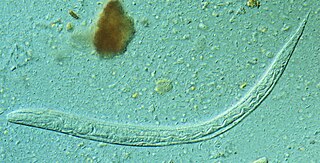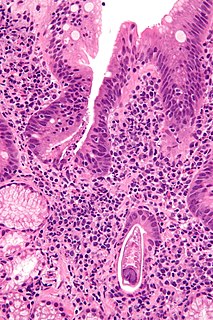 W
WAncylostoma duodenale is a species of the roundworm genus Ancylostoma. It is a parasitic nematode worm and commonly known as the Old World hookworm. It lives in the small intestine of hosts such as humans, cats and dogs, where it is able to mate and mature. Ancylostoma duodenale and Necator americanus are the two human hookworm species that are normally discussed together as the cause of hookworm infection. They are dioecious. Ancylostoma duodenale is abundant throughout the world, including Southern Europe, North Africa, India, China, southeast Asia, some areas in the United States, the Caribbean, and South America.
 W
WAnisakis simplex, known as the herring worm, is a species of nematodes in the genus Anisakis, which occurs in ocean fish such as herrings. Human infections can cause severe abdominal cramps. The worm drills through the intestinal wall and lodges in muscle tissue.
 W
WAscaris lumbricoides is the "large roundworm" of humans, growing to a length of up to 35 cm (14 in). It is one of several species of Ascaris. An ascarid nematode of the phylum Nematoda, it is the most common parasitic worm in humans. This organism is responsible for the disease ascariasis, a type of helminthiasis and one of the group of neglected tropical diseases. An estimated one-sixth of the human population is infected by A. lumbricoides or another roundworm. Ascariasis is prevalent worldwide, especially in tropical and subtropical countries.
 W
WBaylisascaris is a genus of roundworms that infect more than fifty animal species.
 W
WBrugia malayi is a nematode (roundworm), one of the three causative agents of lymphatic filariasis in humans. Lymphatic filariasis, also known as elephantiasis, is a condition characterized by swelling of the lower limbs. The two other filarial causes of lymphatic filariasis are Wuchereria bancrofti and Brugia timori, which both differ from B. malayi morphologically, symptomatically, and in geographical extent.
 W
WDiffuse unilateral subacute neuroretinitis (DUSN) is a rare condition that occurs in otherwise healthy, often young patients and is due to the presence of a subretinal nematode.
 W
WDirofilaria immitis, also known as heartworm or dog heartworm, is a parasitic roundworm that is a type of filarial worm, a small thread-like worm, that causes dirofilariasis. It is spread from host to host through the bites of mosquitoes. There are four genera of mosquitoes that transmit dirofilariasis, Aedes, Culex, Anopheles, and Mansonia. The definitive host is the dog, but it can also infect cats, wolves, coyotes, jackals, foxes, ferrets, bears, seals, sea lions and, under rare circumstances, humans.
 W
WDracunculus medinensis or Guinea worm is a nematode that causes dracunculiasis, also known as guinea worm disease. The disease is caused by the female which, at up to 80 centimetres in length, is among the longest nematodes infecting humans. In contrast, the longest recorded male Guinea worm is only 4 cm.
 W
WGongylonema pulchrum is the only parasite of the genus Gongylonema capable of infecting humans.
 W
WHookworm infection is an infection by a type of intestinal parasite known as a hookworm. Initially, itching and a rash may occur at the site of infection. Those only affected by a few worms may show no symptoms. Those infected by many worms may experience abdominal pain, diarrhea, weight loss, and tiredness. The mental and physical development of children may be affected. Anemia may result.
 W
WLoa loa is the filarial nematode (roundworm) species that causes Loa loa filariasis. Loa loa actually means "worm worm", but is commonly known as the "eye worm", as it localizes to the conjunctiva of the eye. Loa loa is commonly found in Africa. It mainly inhabits rain forests in West Africa and has native origins in Ethiopia. The disease caused by Loa loa is called loiasis and belongs to the so-called neglected diseases.
 W
WMansonella perstans is a vector-borne human filarial nematode, transmitted by tiny blood-sucking flies called midges. Mansonella perstans is one of two filarial nematodes that causes serous cavity filariasis in humans. The other filarial nematode is Mansonella ozzardi. M. perstans is widespread in many parts of sub-Saharan Africa, parts of Central and South America, and the Caribbean.
 W
WNecator americanus is a species of hookworm commonly known as the New World hookworm. Like other hookworms, it is a member of the phylum Nematoda. It is an obligatory parasitic nematode that lives in the small intestine of human hosts. Necatoriasis—a type of helminthiasis—is the term for the condition of being host to an infestation of a species of Necator. Since N. americanus and Ancylostoma duodenale are the two species of hookworms that most commonly infest humans, they are usually dealt with under the collective heading of "hookworm infection". They differ most obviously in geographical distribution, structure of mouthparts, and relative size.
 W
WOnchocerca volvulus is a nematode that causes onchocerciasis, and is the second-leading cause of blindness worldwide after trachoma. It is one of the 20 neglected tropical diseases listed by the World Health Organization, with elimination from certain countries expected by 2020.
 W
WThe pinworm, also known as threadworm or seatworm, is a parasitic worm. It is a nematode (roundworm) and a common intestinal parasite or helminth, especially in humans. The medical condition associated with pinworm infestation is known as pinworm infection (enterobiasis) or less precisely as oxyuriasis in reference to the family Oxyuridae.
 W
WStrongyloides stercoralis is a human pathogenic parasitic roundworm causing the disease strongyloidiasis. Its common name in the US is threadworm. In the UK and Australia, however, the term threadworm can also refer to nematodes of the genus Enterobius, otherwise known as pinworms.
 W
WStrongyloidiasis is a human parasitic disease caused by the nematode called Strongyloides stercoralis, or sometimes S. fülleborni which is a type of helminth. It belongs to a group of nematodes called roundworms. This intestinal worm can cause a number of symptoms in people, principally skin symptoms, abdominal pain, diarrhea and weight loss, among many other specific and vague symptoms in disseminated disease, and severe life-threatening conditions through hyperinfection. In some people, particularly those who require corticosteroids or other immunosuppressive medication, Strongyloides can cause a hyperinfection syndrome that can lead to death if untreated. The diagnosis is made by blood and stool tests. The medication ivermectin is widely used to treat strongyloidiasis.
 W
WThelazia callipaeda is a parasitic nematode, and the most common cause of thelaziasis in humans, dogs and cats. It was first discovered in the eyes of a dog in China in 1910. By 2000, over 250 human cases had been reported in the medical literature.
 W
WTrichinella britovi is a nematode parasite responsible for a zoonotic disease called trichinellosis. Currently, eight species of Trichinella are known, only three of which cause trichinellosis, and Trichinella britovi is one of them. Numerous mammal species, as well as birds and crocodiles, can harbor the parasite worldwide, but the sylvatic cycle is mainly maintained by wild carnivores.
Trichinella spiralis is a viviparous nematode parasite, occurring in rodents, pigs, bears, hyenas and humans, and is responsible for the disease trichinosis. It is sometimes referred to as the "pork worm" due to it being typically encountered in undercooked pork products. It should not be confused with the distantly related pork tapeworm.
 W
WTrichinosis, also known as trichinellosis, is a parasitic disease caused by roundworms of the Trichinella type. During the initial infection, invasion of the intestines can result in diarrhea, abdominal pain, and vomiting. Migration of larvae to muscle, which occurs about a week after being infected, can cause swelling of the face, inflammation of the whites of the eyes, fever, muscle pains, and a rash. Minor infection may be without symptoms. Complications may include inflammation of heart muscle, central nervous system involvement, and inflammation of the lungs.
 W
WTrichuriasis, also known as whipworm infection, is an infection by the parasitic worm Trichuris trichiura (whipworm). If infection is only with a few worms, there are often no symptoms. In those who are infected with many worms, there may be abdominal pain, tiredness and diarrhea. The diarrhea sometimes contains blood. Infections in children may cause poor intellectual and physical development. Low red blood cell levels may occur due to loss of blood.
 W
WTrichuris trichiura, Trichocephalus trichiuris or whipworm, is a parasitic roundworm that causes trichuriasis when it infects a human large intestine. It is commonly known as the whipworm which refers to the shape of the worm; it looks like a whip with wider "handles" at the posterior end.
 W
WWuchereria bancrofti is a human parasitic worm (Filariworm) that is the major cause of lymphatic filariasis. It is one of the three parasitic worms, together with Brugia malayi and B. timori, that infect the lymphatic system to cause lymphatic filariasis. These filarial worms are spread by a variety of mosquito vector species. W. bancrofti is the most prevalent of the three and affects over 120 million people, primarily in Central Africa and the Nile delta, South and Central America, the tropical regions of Asia including southern China, and the Pacific islands. If left untreated, the infection can develop into a chronic disease called lymphatic filariasis. In rare conditions, it also causes tropical eosinophilia, an asthmatic disease. No vaccine is commercially available, but high rates of cure have been achieved with various antifilarial regimens and lymphatic filariasis is the target of the WHO Global Program to Eliminate Lymphatic Filariasis with the aim to eradicate the disease as a public-health problem by 2020.